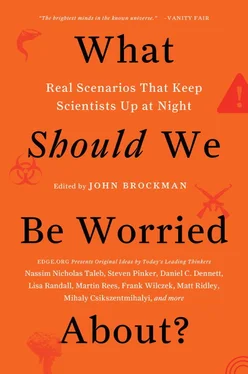Nothing has slowed space development more than the high price of moving mass around the solar system. Using two stages to get into low Earth orbit may make substantial improvements, and beyond that the right answer may lie in nuclear rockets. These have been developed since the 1960s and could be improved still further. Lofting them into orbit “cold”—that is, before turning on the nuclear portion—may well erase the environmental issues. Fuel fluids can be flown up separately, for attachment to the actual rocket drive. Then the nuclear segment can heat the fuel to very high temperatures. Economically this seems the most promising way to develop an interplanetary economy for the benefit of humanity.
Such ideas have been tried out in the imaginative lab of science fiction, exploring how new technologies could work in a future human context. Kim Stanley Robinson’s 2012 visionary novel, 2312, portrays such a solar system economy. Our reborn entrepreneurial space culture emerged from an earlier epoch that saw space as the inevitable next horizon. The fresh industrial reality is already making a larger cultural echo in novels, films, and much else. It’s a space era again.
Sagan spoke often of how the view from space gave us perspective on our place in the cosmos. That started with Apollo 8’s 1968 swing around our moon and its backward look at Earth. Many felt, looking at those photos, that future exploration of space should focus on ways to protect Earth and extend human habitation beyond it. Sagan had the idea of turning Voyager to look back at ourselves and told us to take the larger perspective in his Pale Blue Dot: A Vision of the Human Future in Space.
That first flowering into space set a tone we should embrace. In the end, history may resemble a zero-sum game ruled by resources. We can win such a game only by breaking out of its assumptions. Babylonian astrologers thought the stars governed our fates. A thousand years ago, societies were largely religious and prayed to the skies for their salvation. We can seek our futures there now as well. And an age might come when we shall govern the fate of stars.
SETH SHOSTAK
Senior astronomer, SETI Institute; author, Confessions of an Alien Hunter
The recent reset of the long-count Mayan calendar didn’t end the world. But there are serious scientists who worry that Armageddon could soon be headed our way, although from a different quarter—an attack by malevolent extraterrestrial beings.
The concern is that future radio broadcasts to the stars, intended to put us in touch with putative aliens, might carelessly betray our presence to a warlike society and jeopardize the safety of Earth. The physicist Stephen Hawking has weighed in on this dreadful possibility, suggesting that we should be careful about sending signals that could trigger an aggressive reaction from some highly advanced race of extraterrestrials.
It all sounds like shabby science fiction, but even if the probability of disaster is low, the stakes are high. Consequently, some cautious researchers argue that it’s best to play safe and keep our broadcasts to ourselves. Indeed, they urge a worldwide policy of restraint and relative quiet. They would forbid the targeting of other star systems with transmissions of greater intensity than the routine radio and television that inevitably leak off our planet.
That sounds like a harmless precaution, and who would quibble about inexpensive insurance against the possible obliteration of our world. But this is one worry I don’t share. Even more, I believe the cure is more deadly than the disease. To fret about the danger of transmissions to the sky is both too late and too little. Worse, it will endlessly hamstring our descendants.
Ever since the Second World War, we’ve been broadcasting high-frequency signals that can easily penetrate Earth’s ionosphere and seep into space. Many are television, FM radio, and radar. And despite the fact that the most intense of these transmissions sport power levels of hundreds of thousands of watts or more, they dwindle to feeble static at distances measured in light-years. Detecting them requires a very sensitive receiving setup.
As an example of the difficulty, consider an alien society that wields an antenna comparable to the Arecibo telescope in Puerto Rico—1,000 feet in diameter and the largest single-element radio telescope on Earth. This antenna would be unable to pick up our television broadcasts even from the distance of Proxima Centauri, which, at 4.2 light-years, is our nearest stellar neighbor. And it’s improbable that we have cosmic confreres this close, or even ten or twenty times farther. Astronomers such as Frank Drake and the late Carl Sagan have estimated that the nearest Klingons (or whatever their species) are at least a few hundred light-years away. Our leakage signals—when they eventually reach that far—will be orders of magnitude weaker than any our best antennas could detect.
Such arguments might appear to justify the suggestion by the self-appointed defenders of Earth that we need not fear our current broadcasts; they will be undetectably weak. But they claim that we should concern ourselves with deliberate, highly targeted (and therefore highly intense) transmissions. We can continue to enjoy our sitcoms and shopping channels, but we should forbid anyone from shouting in the galactic jungle.
There’s a serious flaw in this apparently plausible reasoning. Any society able to do us harm from the depths of space is not at our technological level. We can confidently assume that a culture able to project force to someone else’s star system is at least several centuries in advance of us. This statement is independent of whether you believe that such sophisticated beings would be interested in wreaking havoc and destruction. We speak only of capability, not motivation.
Therefore it’s reasonable to expect that any such advanced beings, fitted out for interstellar warfare, will have antenna systems far larger than our own. In the second half of the 20th century, the biggest of the antennas constructed by Earthly radio astronomers increased by a factor of 10,000 in collecting area. It hardly strains credulity to assume that Klingons hundreds or thousands of years farther down the technological road will possess equipment fully adequate to pick up our leakage. Consequently, the signals we send willy-nilly into the cosmos—most especially our strongest radars—are hardly guaranteed to be “safe.”
There’s more. Von R. Eshleman, a Stanford University engineer, pointed out decades ago that by using a star as a gravitational lens you can achieve the ultimate in telescope technology. This idea is a straightforward application of Einstein’s general theory of relativity, which predicts that mass will bend space and affect the path of light beams. The prediction is both true and useful: Gravitational lensing has become a favored technique for astronomers who study extremely distant galaxies and dark matter.
However, there’s an aspect of this lensing effect that’s relevant to interstellar communication: Imagine putting a telescope (radio or optical) onto a rocket and sending it to the sun’s gravitational focus—roughly twenty times the distance of Pluto. When aimed back at the sun, the telescope’s sensitivity will be increased by thousands or millions of times, depending on wavelength. Such an instrument would be capable of detecting even low-power signals (far weaker than your local top-forty FM station) from 1,000 light-years away. At the wavelengths of visible light, this setup would be able to find the street lighting of New York or Tokyo from a similar remove. Consequently, it’s indisputable that any extraterrestrials with the hardware necessary to engage in interstellar warfare will be able to heft telescopes to the comparatively piddling distance of their home star’s gravitational focus.
Читать дальше












